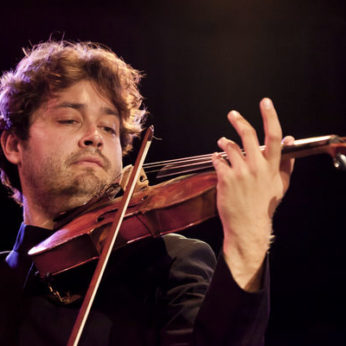Composer: Felix Mendelssohn-Bartholdy (b. 1809 - d. 1847)
Performance date: 05/07/2016
Venue: St. Brendan’s Church
Composition Year: 1845
Duration: 00:29:12
Recording Engineer: Richard McCullough, RTÉ lyric fm
Instrumentation Category:String Quintet
Artists:
Borusan Quartet (Esen Kıvrak, Olgu Kızılay [violins], Efdal Altun [viola], Cağ Ercağ, [cello]) -
[quartet]
Lawrence Power -
[viola]

Mendelssohn’s output
of chamber music is not large, but he began his composing career with chamber
music and was always longing to return to it. He wrote the first string quintet
in 1826, revising it in 1832 after the death of a friend, and wrote the second
in 1845, one of a number of chamber works written during the last four years of
his life, culminating in the extraordinary F minor Quartet.
He wrote the Second
Quintet during a period of respite from his extensive duties as official
composer to the
and to return to the string quintet genre twenty years after his previous work.
Like Beethoven and Mozart he wrote for a quintet with two violas unlike Schubert
and Boccherini, who both took the other route with a second cello. Mendelssohn
was extremely self-critical and was so dissatisfied with the exuberant finale
of the Second Quintet that he refused to allow it to be published. He probably
intended to rework some of it, but died before he could do so and the work was
published posthumously as Op.87.
Mendelssohn’s First
Quintet is full of youthful exuberance and the Second is more thoughtful and
restrained, but both share the same structural principles and style. The
opening of the first movement of Op.87 appears to be an attempt to recapture
the sparkling freshness and atmosphere of his youthful masterpiece, the String Octet,
for there is a strong similarity in the outline of the themes of the two works.
In the sonata form first movement the violins play a triadic theme above a
tremolo accompaniment, which is interrupted by a triplet figure that eventually
returns accompanying the contrasting cantabile
theme. After a development section rich in tonal, textural and dynamic
contrast, Mendelssohn uses additional contrapuntal techniques in the
recapitulation to further expand the two principal themes.
The light, playful
second movement is typical of Mendelssohn’s scherzos. He achieves this quality
through alternating pizzicato and arco writing, and by treating a staccato melody fugally. The music
shifts between major and minor modes, thus creating harmonic variety.
The third movement
is in D minor and is in direct contrast with the previous movement, replacing counterpoint
and frivolity with a chordal texture and dramatic harmonies and melodies. The
varied dynamics and instrumental effects create an impression that is almost
symphonic in concept, and the movement demonstrates Mendelssohn’s skill in
treating typically Romantic harmonic and instrumental colour with a Classical
refinement and balance. The finale returns the work to its original
light-hearted state, the violins and violas in particular propelling the
movement with their bustling energy.
Copyright © 2024 West Cork Music. All rights reserved.
Designed and developed by Matrix Internet